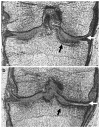Magnetic resonance imaging evaluation of weight-bearing subchondral trabecular bone in the knee
- PMID: 20449585
- PMCID: PMC3886640
- DOI: 10.1007/s00256-010-0943-z
Magnetic resonance imaging evaluation of weight-bearing subchondral trabecular bone in the knee
Abstract
Objective: Changes in weight-bearing subchondral bone are central to osteoarthritis (OA) pathophysiology. Using MR, knee trabecular bone is typically assessed in the axial plane, however partial volume artifacts limit the utility of MR methods for femorotibial compartment subchondral bone analysis. Oblique-coronal acquisitions may enable direct visualization and quantification of the expected increases in femorotibial subchondral trabecular bone.
Methods: MR acquisition parameters were first optimized at 3 Tesla. Thereafter, five volunteers underwent axial and coronal exams of their right knee. Each image series was evaluated visually and quantitatively. An anatomically standardized region-of-interest was placed on both the medial and lateral tibial plateaus of all coronal slices containing subchondral bone. Mean and maximum marrow signal was measured, and "bone signal" was calculated.
Results: The MR acquisition had spatial resolution 0.2 × 0.2 × 1.0 mm and acquisition time 10.5 min. The two asymptomatic knees exhibited prominent horizontal trabeculae in the tibial subchondral bone, while the one confirmed OA knee had disorganized subchondral bone and absent horizontal trabeculae. The subchondral bone signal was 8-14% higher in both compartments of the OA knee than the asymptomatic knees.
Conclusion: The weight-bearing femorotibial subchondral trabecular bone can be directly visualized and changes quantified in the coronal-oblique plane. Qualitative and quantitative assessments can be performed using the resultant images and may provide a method to discriminate between the healthy and OA knees. These methods should enable a quantitative evaluation of the role of weight-bearing subchondral bone in the natural history of knee OA to be undertaken.
Conflict of interest statement
Figures







Similar articles
-
Association of subchondral bone marrow lesion localization with weight-bearing pain in people with knee osteoarthritis: data from the Osteoarthritis Initiative.Arthritis Res Ther. 2021 Jan 19;23(1):35. doi: 10.1186/s13075-021-02422-0. Arthritis Res Ther. 2021. PMID: 33468243 Free PMC article.
-
Quantitative regional and sub-regional analysis of femoral and tibial subchondral bone mineral density (sBMD) using computed tomography (CT): comparison of non-osteoarthritic (OA) and severe OA knees.Osteoarthritis Cartilage. 2017 Nov;25(11):1850-1857. doi: 10.1016/j.joca.2017.07.014. Epub 2017 Jul 23. Osteoarthritis Cartilage. 2017. PMID: 28743608
-
Osteoporotic changes of subchondral trabecular bone in osteoarthritis of the knee: a 3-T MRI study.Osteoporos Int. 2012 Feb;23(2):589-97. doi: 10.1007/s00198-011-1585-2. Epub 2011 Feb 26. Osteoporos Int. 2012. PMID: 21359670
-
Modeling knee osteoarthritis pathophysiology using an integrated joint system (IJS): a systematic review of relationships among cartilage thickness, gait mechanics, and subchondral bone mineral density.Osteoarthritis Cartilage. 2018 Nov;26(11):1425-1437. doi: 10.1016/j.joca.2018.06.017. Epub 2018 Jul 26. Osteoarthritis Cartilage. 2018. PMID: 30056214
-
Subchondral bone changes in hand and knee osteoarthritis detected by radiography.Osteoarthritis Cartilage. 2004;12 Suppl A:S10-9. doi: 10.1016/j.joca.2003.09.007. Osteoarthritis Cartilage. 2004. PMID: 14698636 Review.
Cited by
-
Effect of intra-articular injection of intermediate-weight hyaluronic acid on hip and knee cartilage: in-vivo evaluation using T2 mapping.Eur Radiol. 2018 Jun;28(6):2345-2355. doi: 10.1007/s00330-017-5186-0. Epub 2018 Jan 9. Eur Radiol. 2018. PMID: 29318429
-
Subchondral bone trabecular integrity predicts and changes concurrently with radiographic and magnetic resonance imaging-determined knee osteoarthritis progression.Arthritis Rheum. 2013 Jul;65(7):1812-1821. doi: 10.1002/art.37970. Arthritis Rheum. 2013. PMID: 23576116 Free PMC article.
-
Periarticular bone predicts knee osteoarthritis progression: Data from the Osteoarthritis Initiative.Semin Arthritis Rheum. 2018 Oct;48(2):155-161. doi: 10.1016/j.semarthrit.2018.01.008. Epub 2018 Jan 31. Semin Arthritis Rheum. 2018. PMID: 29449014 Free PMC article.
-
Association between knee alignment, osteoarthritis disease severity, and subchondral trabecular bone microarchitecture in patients with knee osteoarthritis: a cross-sectional study.Arthritis Res Ther. 2020 Sep 4;22(1):203. doi: 10.1186/s13075-020-02274-0. Arthritis Res Ther. 2020. PMID: 32887657 Free PMC article.
-
The influence of zinc and iron intake on osteoarthritis patients' subchondral sclerosis progression: A prospective observational study using data from the osteoarthritis Initiative.Heliyon. 2023 Nov 4;9(11):e22046. doi: 10.1016/j.heliyon.2023.e22046. eCollection 2023 Nov. Heliyon. 2023. PMID: 38027819 Free PMC article.
References
-
- Moskowitz RW. Bone remodeling in osteoarthritis: subchondral and osteophytic responses. Osteoarthritis Cartilage. 1999;7:323–4. - PubMed
-
- Lajeunesse D. The role of bone in the treatment of osteoarthritis. Osteoarthritis Cartilage. 2004;12(Suppl A):S34–8. - PubMed
-
- Karsdal MA, Leeming DJ, Dam EB, Henriksen K, Alexandersen P, Pastoureau P, et al. Should subchondral bone turnover be targeted when treating osteoarthritis? Osteoarthritis Cartilage. 2008;16:638–46. - PubMed
-
- Lajeunesse D, Hilal G, Pelletier JP, Martel-Pelletier J. Subchondral bone morphological and biochemical alterations in osteoarthritis. Osteoarthritis Cartilage. 1999;7:321–2. - PubMed
Publication types
MeSH terms
Grants and funding
LinkOut - more resources
Full Text Sources

